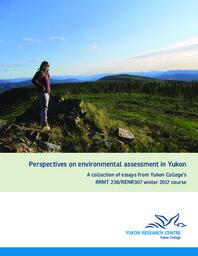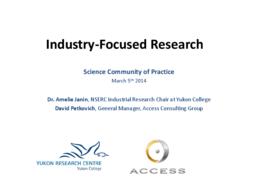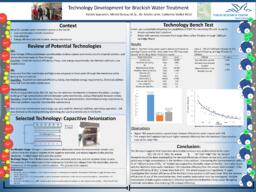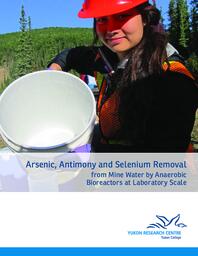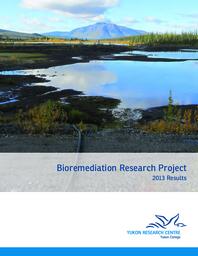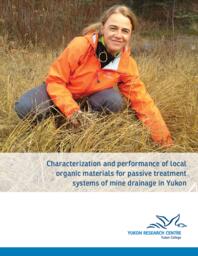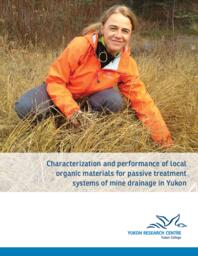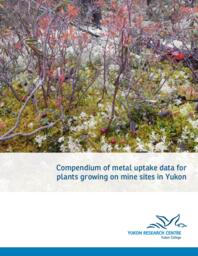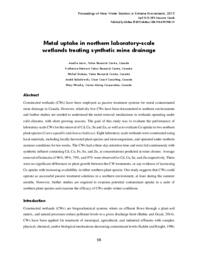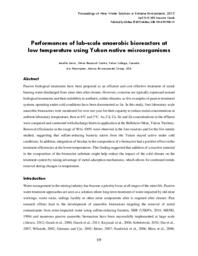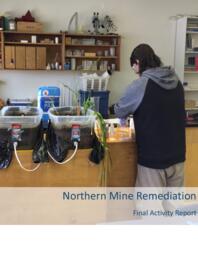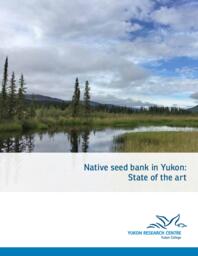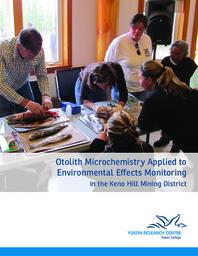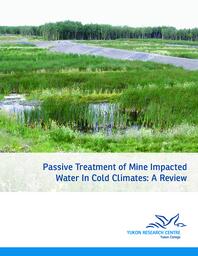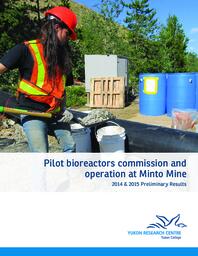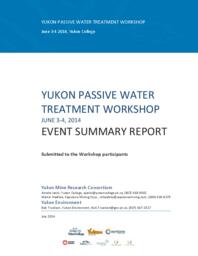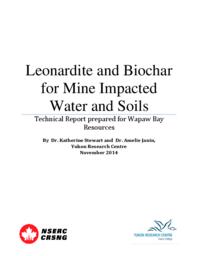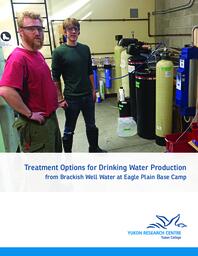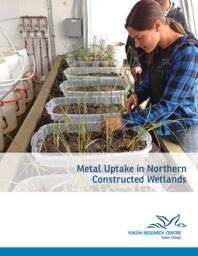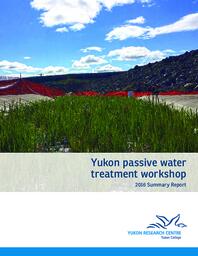Janin, Amelie
Person Preferred Name
Amelie Janin
Affiliation
Related Works
Content type
Digital Document
Description / Synopsis
Environmental and socio-economic effects assessment ensures that the effects of development activities are considered before they happen and that significant adverse effects will be mitigated. Dr. Amelie Janin, NSERC Industrial Research Chair in Mine Life Cycle at Yukon College taught this course over the Winter 2017. Through discussions with a series of guest speakers and with the instructor, the students were tasked to reflect on the environmental assessment process in Yukon and to write short essays. The essays have been compiled under one document.
Origin Information
Content type
Digital Document
Description / Synopsis
Conference presentation for the Science Community of Practice (SCOPe)
Origin Information
Content type
Digital Document
Origin Information
Content type
Digital Document
Description / Synopsis
Passive water treatment technologies are increasingly being considered for mine site closure in the Yukon and efforts are currently underway to test, compare and contrast passive treatment technologies with conventional technologies. This study aims to provide additional information about the effectiveness of passive treatment technologies for mine water treatment in cold climates. To test the hypothesis that bioreactors can effectively treat mine-impacted water at low temperatures, four bench-scale, continuous flow bioreactors were assessed for their potential to remove As, Se and Sb from mine effluent. The experiment was conducted as part of the work undertaken by the Yukon Mine Research Consortium; an industrial research body which conducts research on remediation and reclamation of Yukon mine sites to further enhance environmental stewardship in the territory. More specifically, the objectives of this study were to 1) assess the efficiency of removal of As, Sb and Se, three metalloids, from a highly contaminated synthetic drainage in cold conditions as well as from actual leachate collected at the Eagle Gold site, 2) evaluate the impact of using wood chips as part of the composition of the bioreactor and 3) assess the impact of freeze/thaw on the bioreactors’ performance. Four bioreactors in columns were built in the Yukon Research Centre lab and operated for 5 months to treat both synthetic influent and leachate collected at Eagle Gold during summer 2014. Operation was phased as follows: Phase 1) the bioreactors were operated in an environment with uncontrolled temperature in the fall until the bioreactors froze solid; Phase 2) the bioreactors were thawed in a fridge at a stable temperature of 6°C; Phase 3) the bioreactors were operated and monitored at 6°C. Results show that all bioreactors significantly decreased As, Sb and Se concentrations even when the influent concentration was high (mimicking the “worst case scenario”). However, even though As reduction was efficient, it was not quite enough to bring the concentrations below the discharge limit threshold of 0.15 ug/L. Using drainage produced on site, 38%, 90% and 95% of As, Se and Sb was removed. Using highly contaminated drainage with an average of 5 mg/L As, 0.5 mg/L Se and 0.03 mg/L Sb, the removal efficiencies were recorded at >85% for Sb, >87% for As, and >99% for Se. This study is one of very few studies reported in the literature which demonstrates antimony removal from water by an anaerobic bioreactor. In addition to the metal removal performance assessment, the results indicate that addition of 20% spruce chips in the composition of the bioreactor substrate improved As removal in the first phase of the study and helped mitigate the impact of freeze/thaw on As, Sb and Se.
Origin Information
Content type
Digital Document
Description / Synopsis
The purpose of this document is to report the results of the Bioremediation Project conducted by the Industrial Research Chair in Mine Life Cycle at Yukon College, between February 2013 to January 2014, to the industrial partners Alexco Resource Group, Capstone Mining Corp, Victoria Gold Corp and Yukon Zinc Corp. Passive water treatment has been identified as one of the areas of focus by the four partners who likely plan to use some sort of biological passive treatment systems at closure (closure plans of Minto, Wolverine, Bellekeno, and likely Eagle Gold) or during operation (Wolverine Mine, possibly Eagle Gold) whether this is wetlands, anaerobic bioreactors, electro-biochemical reactor or a combination of these techniques. Using passive biological treatment at mines in the North can be challenging due to the regulators lacking confidence in this type of technology due to limited Northern operational experience in applying these systems. A common concern relates to the efficiency of biological systems at cold temperature. To address that particular issue, research was conducted through the Chair program, starting in January 2013, to assess and compare different substrates for their potential to support bioreactor efficiencies." -- p.3
Origin Information
Content type
Digital Document
Description / Synopsis
Passive treatment systems (PTS) present a potential low-cost solution to treating mine-impacted waters (MIW) and impeding release of contaminants, such as metals and sulphate, into receiving waters in remote mine sites in Yukon. Nevertheless, the traditional carbon substrates used to maintain efficient functioning of these systems (i.e., molasses) are not readily available and can be expensive in remote locations. Moreover, the extensive periods of cold temperatures experienced in Yukon may impede the biological functioning of PTS. The goal of this study is to characterize a selection of local organic materials that may be used as complex carbon substrates for PTS and evaluate their potential performance as carbon substrates in the Yukon environment. In the first part of the study, the physiochemical properties of six local complex carbon substrates: willow leaves (Salix sp.), sedges (Carex sp.), peat, peat moss (Sphagnum), poplar (Populus sp.), wood chips, and spruce (Picea sp.) wood chips were characterized. In the second part, bench-scale bioreactors containing organic substrates, were used to evaluate carbon substrate degradation and the performance of bioreactors for sulphate and metal reduction from synthetic mine water at low temperatures for approximately five months.
Origin Information
Content type
Digital Document
Description / Synopsis
Passive treatment systems (PTS) present a potential low-cost solution to treating mine-impacted waters (MIW) and impeding release of contaminants, such as metals and sulphate, into receiving waters in remote mine sites in Yukon. Nevertheless, the traditional carbon substrates used to maintain efficient functioning of these systems (i.e., molasses) are not readily available and can be expensive in remote locations. Moreover, the extensive periods of cold temperatures experienced in Yukon may impede the biological functioning of PTS. The goal of this study is to characterize a selection of local organic materials that may be used as complex carbon substrates for PTS and evaluate their potential performance as carbon substrates in the Yukon environment. In the first part of the study, the physiochemical properties of six local complex carbon substrates: willow leaves (Salix sp.), sedges (Carex sp.), peat, peat moss (Sphagnum), poplar (Populus sp.), wood chips, and spruce (Picea sp.) wood chips were characterized. In the second part, bench-scale bioreactors containing organic substrates, were used to evaluate carbon substrate degradation and the performance of bioreactors for sulphate and metal reduction from synthetic mine water at low temperatures for approximately five months.
Origin Information
Content type
Digital Document
Description / Synopsis
This document is meant as a report on, and a supplement to the Metals Uptake Database (www.yukoncollege.yk.ca/research), completed in the summer of 2017. It acts to summarize and report on certain aspects of the data contained within the database, and highlight the literature from which data in the database was retrieved. The general purpose of this project was to compile information on the uptake of metals by different plant species in the North, specifically on mine-impacted sites, in order to compare this data to the scientific literature on species specific metal uptake. To this end, literature of this type was gathered from a number of sources for both the Yukon and Alaska.
Origin Information
Content type
Digital Document
Description / Synopsis
Constructed wetlands (CWs) have been employed as passive treatment systems for metal contaminated mine drainage in Canada. However, relatively few CWs have been documented in northern environments and further studies are needed to understand the metal removal mechanisms in wetlands operating under cold climates, with short growing seasons. The goal of this study was to evaluate the performance of laboratory-scale CWs for the removal of Cd, Cu, Se and Zn, as well as to evaluate Cu uptake in two northern plant species (Carex aquatilis and Juncus balticus). Eight laboratory-scale wetlands were constructed using local materials, including locally harvested plant species and microorganisms, and operated under northern summer conditions for ten weeks. The CWs had a three-day retention time and were fed continuously with synthetic influent containing Cd, Cu, Fe, Se, and Zn, at concentrations predicted at mine closure. Average removal efficiencies of 96%, 99%, 79%, and 97% were observed for Cd, Cu, Se, and Zn respectively. There were no significant differences in plant growth between the CW treatments, or any evidence of increasing Cu uptake with increasing availability in either northern plant species. Our study suggests that CWs could operate as successful passive treatment solutions in a northern environment, at least during the summer months. However, further studies are required to examine potential contaminant uptake in a suite of northern plant species and examine the efficacy of CWs under winter conditions.
Origin Information
Content type
Digital Document
Description / Synopsis
Passive biological treatments have been proposed as an efficient and cost effective treatment of metal bearing water discharged from mine sites after closure. However, concerns are typically expressed around biological treatments and their suitability in northern, colder climates, as few examples of passive treatment systems operating under cold conditions have been documented so far. In this study, four laboratory scale anaerobic bioreactors were monitored for over one year for their capacity to reduce metal concentrations at ambient laboratory temperature, then at 6°C and 3°C. As, Cd, Cu, Se and Zn concentrations in the effluent were compared and contrasted with discharge limits in application at the Bellekeno Mine, Yukon Territory. Removal efficiencies in the range of 90 to 100% were observed in the four reactors and for the five metals studied, suggesting that sulfate-reducing bacteria native from the Yukon stayed active under cold conditions. In addition, integration of biochar in the composition of a bioreactor had a positive effect on the treatment efficiencies at the lower temperatures. This finding suggested that addition of a reactive material in the composition of the bioreactor substrate might help reduce the impact of the cold climate on the treatment system by taking advantage of metal adsorption mechanisms, which allows for continued metals removal during changes in temperature.
Origin Information
Content type
Digital Document
Description / Synopsis
The Northern Mine Remediation project began with the formation of the Yukon Mining Research Committee (YMRC) in 2012. As representatives of the mining industry they wanted to create a platform for industry, Yukon College, First Nations, and governments to work collaboratively in in addressing environmental challenges faced by the mining industry in Yukon and determining effective mechanisms for sustainable, environmentally-safe mining practices. YMRC wanted to increase the knowledge, skills and abilities of Yukoners in environmental research and practice, and have First Nations and local communities affected by the mining industry become knowledgeable and engaged in environmental research. Through an active partnership, the YMRC mandated Yukon College (Dr. Janin) to conduct research at Yukon College to collaborate in the development of the northern mining industry. The Yukon College received CanNor funding in order to complete research activities that will reduce the environmental risks and costs associated with mining in the North.
Origin Information
Content type
Digital Document
Description / Synopsis
The revegetation needs in the Yukon are projected to grow in the next few years as new mining projects go through the environmental assessment process, and plans for the revegetation of large-scale abandoned mines begin to take shape. Revegetation strategies and needs vary within the Yukon, but when dispersing seed or using seedlings, the use of native species that are locally produced is considered best practice. The lack of a clear source for this type of material was indicated as a barrier to the implementation of these best practices in the Yukon. To explore this topic further, industry, consultants, and experts involved in seed collection, storing, sourcing, and propagation initiatives were interviewed. This report is based on those interviews and examines the state of revegetation in the Yukon, current options for native seed sourcing, and potential future options that would increase access to native seeds in the territory. These options include the development of seed collection, banking, and propagation initiatives, as well as educational programming to support these initiatives. Several case studies are included, both covering local initiatives and initiatives in other jurisdictions that are relevant to the Yukon and could be used as a model for local seed and plant sourcing initiatives.
Origin Information
Content type
Digital Document
Description / Synopsis
The overall goal of this project was to assess, in three stages, the use of fish otolith microchemistry as a potentially new monitoring tool to be applied around Yukon mine sites. High quality environmental assessments are critical to sound land and water use management as part of all mining development. Improvement of the environmental assessment and prediction of potential impact of land use activities rely on the development of scientific tools and techniques. Fish otolith chemistry integrates information on contaminant exposure and life history of both individual fish and populations. This technique affords a unique opportunity: otoliths consist of a calcium carbonate structure in the inner ear of fish deposited in daily to annual increments. They have been used to determine age and life history events of fish and fish populations. As otoliths are metabolically stable, the contaminant levels within their annular structure can provide a temporal record of exposure of the fish to trace metals and can be used to get baseline data information required for environmental assessments and reconstruct historical exposure for the further protection of aquatic wildlife. As new mining projects are developing in the Yukon, it is believed that Yukon would benefit in establishing a fish otolith chemistry technique and database with the local population, which in turn gave rise to this project.
Origin Information
Content type
Digital Document
Description / Synopsis
In this review, we evaluate the challenges encountered and the adaptations required for the successful treatment of mine-impacted waters in cold climates with Passive Treatment Systems (PTSs). Engineered PTSs are modeled on natural wetlands, which have been shown to effectively treat water with high metal concentrations through natural attenuation. PTSs include constructed wetlands, bioreactors, and hybrid systems. Some of the challenges associated with implementing cold climate PTSs include cold temperatures, remote locations and limited access in winter, which can lead to freezing pipes and surface water, variable seasonal flow, and low productivity of microbial and macrophytic communities. Many adaptations have been implemented to address these cold climate challenges including burial of pipes to avoid hydraulic failure, insulation to avoid freezing surface waters, bypasses and overflows to maintain constant flow, summer establishment of microbial and macrophytic communities and the addition of liquid carbon sources to offset reduced organic matter decomposition in cold temperatures. While further investigation and development is necessary to fully understand the factors affecting cold climate PTSs, with sufficient research and planning PTSs can be successfully implemented in cold climates.
Origin Information
Content type
Digital Document
Description / Synopsis
Four (4) pilot anaerobic bioreactors were commissioned at the Minto mine site in the summer of 2014 by Amelie Janin, NSERC Industrial Research Chair at Yukon College, and Capstone staff. Installation was completed on August 7th, 2014 and operation started on August 20th, 2014. Bioreactor substrate composition varied among the bioreactors and included mixtures of creek sediments, low-grade or river gravel, wood chips or biochar (a coal made out of wood). During the first year the bioreactors were monitored until September 23rd, 2014, after which they were dismantled and stored for the winter. In the following year, the bioreactors resumed operation on June 2nd and were monitored between June 20th, 2015 and September 26th, 2015.
Origin Information
Content type
Digital Document
Description / Synopsis
The goal of Yukon Passive Water Treatment Workshop was to foster discussions between mines environmental personnel, regulators, project managers, consultants, design engineers, and other affected stakeholders to identify the gaps that need to be addressed. The specific objectives were: 1. Facilitate communication between stakeholders and set up an environment for constructive discussion on progressing passive water treatment systems in the Yukon. 2. Identify constraints, gaps, and reservations that industry, regulators, and researchers encounter. 3. Increase knowledge-sharing 4. Encourage the development of plans on how to address these issues. This event was planned and organized by Amelie Janin, NSERC Industrial Research Chair at Yukon College, Bob Truelson, Manager, Water Quality Section with Environment Yukon, and Martin Haefele, Permitting Manager at Capstone Mining Corp. Forty-seven participants attended the workshop, representing the various stakeholders.
Origin Information
Content type
Digital Document
Description / Synopsis
In situ immobilization of metals using soil amendment processes is increasingly being considered as an effective and low cost remediation alternative (Mench et al. 2007, Kumpiene et al. 2008, Fellet et al. 2011). Leonardite is a carbon-rich material derived from the oxidation of Lignite and is rich in humic acid, whereas biochar is a product that results from the oxygen limited, pyrolysis of various biological ingredients, such as wood, fish or animal bone. Several studies have found biochar amendments result in significant decreases in the bioavailability of heavy metals associated with mining impacted soils (Namgay et al. 2006, Fellet et al. 2011, Beesley et al. 2010) and simultaneously improve physical, chemical and biological soil properties (Laird et al. 2010). Leonardite is known to improve soil conditions (Lao et al. 2005, Zeledόn- Torunõ et al. 2005, Madejόn et al. 2010) and has potential to significantly reduce metal bioavailability due to high metal adsorption capacity (Lao et al. 2005, Zeledόn- Torunõ et al. 2005).
Origin Information
Content type
Digital Document
Description / Synopsis
Northern Cross Yukon Ltd. is in the process of electing a treatment method for drinking water provision at their base camp situated in Eagle Plains, Yukon Territory (Canada). An experiment was conducted at the Yukon Research Centre for comparing three treatment train options that were proposed by different stakeholders.
Origin Information
Content type
Digital Document
Description / Synopsis
Constructed wetlands (CWs) have been employed as passive treatment systems for metal contaminated mine drainage in Canada. However, relatively few CWs have been documented in northern environments and further studies are needed to understand the metal removal mechanisms in wetlands operating under cold climates, with short growing seasons. The goal of this study was to evaluate the performance of laboratory-scale CWs for the removal of Cd, Cu, Se and Zn, as well as, to evaluate Cu and Se uptake in two northern plant species (Carex aquatilis and Juncus balticus). Eight laboratory-scale wetlands were constructed using local materials, including locally harvested plant species and microorganisms and operated under northern summer conditions for 10 weeks. The CWs were fed continuously with synthetic influent containing Cd, Cu, Fe, Se and Zn at concentrations predicted at mine closure. Average removal efficiencies of 96%, 99%, 79% and 97% were observed for Cd, Cu, Se and Zn respectively. There were no significant differences in plant establishment or growth between our CW treatments, or any evidence of increasing Cu uptake with increasing contaminant availability in either northern plant species. Increased belowground uptake of Se was observed at the higher influent concentration in the Pit treatment. However, overall our study suggests that uptake of contaminants by these two northern species is very minor (<0.06% Cu and <0.11% Se, except for C. aquatilis in one treatment <0.2% Cu and <0.4 % Se) and likely does not pose a risk to the surrounding environment. We conclude that CWs could operate as successful passive treatment solutions in a northern environment, at least during the summer months, pending further studies on winter treatment. Further studies are required to examine seasonal metal removal rates in relation to rates of sulfate reduction, carbon consumption, metal precipitation and sorption. In addition, potential contaminant uptake and the influence of functional plant characteristics on metal removal in a suite of northern plant species would further assist in the development of large-scale long-term northern CWs.
Origin Information
Content type
Digital Document
Description / Synopsis
As passive water treatment technologies are increasingly being considered as a part of mine site closure in Yukon, it is important for industry to share with the government the questions they have, and vice versa. Efforts are currently underway by industry in partnership with the Industrial Research Chair in Mine Life Cycle at Yukon College to test passive water treatment technologies. The overall objective of this workshop was to understand how research on passive water treatment systems can be used to help industry achieve expectations set by First Nations and regulatory bodies.
Origin Information

